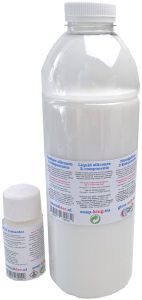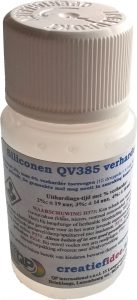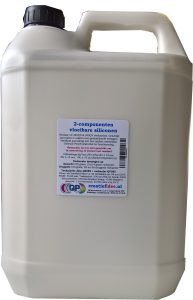Easy making a mold with Liquid silicone rubber
(Liquid siliconen / silicone rubber)
Liquid silicone, also called liquid silicone rubber or liquid rubber, is extremely suitable for making a mold from an existing figure/image on a simple and cheap way.
You mix the two-component (polycondensation) liquid silicone together, then you can spread it or cast it into a mold. This is then suitable for making candles or soap, for example. Making a copy of (precious) items is so simple!
Tip: it is also possible to make the silicone thinner with silicone oil.
You can make anything in the mold you make, because the silicone is suitable for temperatures up to 400 degrees, the possibilities are endless. The standard cast silicone is not suitable for making food, we have special food safe silicone for this. From small packaging of 1 kilo, 5 kilos to even a barrel of 200 kilos. The larger the packaging, the lower the price per kilo! We supply it up to 5 kilos in a handy packaging (bottle or jerry can) for easy pouring (not packed in a can, which makes it more likely to spill).

A in B component
The liquid silicone QS22 / pourable silicone consists of an A and B component. When these two are mixed together, the liquid silicone will harden.
You can also dilute the silicone with silicone oil (max 10%), the advantage of this is that it’s thinner, so it it’s easier to pour. It also flows better in the mold, another advantage is that it is cheaper than silicone, so you get more for less money.
With the addition of 5% hardener (hardener = B-component) it will take 24 to 20 hours before the silicone has hardened.
You can add more hardener, but you have the risk that not all air bubbles have disappeared from the mold before the silicone has hardened.
The hardener weighs less than a gram/ml and the silicone weighs more. It is important to first determine whether you are going to work on weight or content. In both examples we weigh the silicone, but the hardener is added by weight or drops.
Add hardener by weight (preferred)
Use 5 grams of hardener per 100 grams of silicone (accelerates the curing time)
Add hardener with drops
Use 5 grams of hardener per 100 grams of silicone (almost 5 ml).
15 drops is ± 1 ml, so for 100 grams with 5% addition there are Needs 75 drops.
Used 50 grams per kilo of silicone.
What you need:
- Liquid silicone (A-component) & hardener (B-component)
- Measuring cup + plastic spoon to mix
- Plasticine clay to seal seams
- Polyvinyl alcohol (option)
- Silicone oil (option)
- Double-sided tape & tape
- Big plate
- Placemat
- Kitchen scale

It is important to have a solid flat surface, a flat plate is a good solution. Then fix the object of what you want to make a mold with a piece of double sided tape and fix it in the middle of the plate (what later the bottom is have to be fixed on the board).
Grab a placemat or another thick flexible plastic sheet and turn it around to the object with a 3mm space around the object. Then slice across the seam of the placemat adhesive tape so the palcemat is closed. To be sure tape also on the outside.
Plasticine clay
The advantage of this plasticine clay is that it does not harden, so it does not tear, preventing the silicone from leaking out of the placemat. The clay can simply be reused later. Make a roll of plasticine clay like bake bread and create a circle of the size of the placemat. The plasticine clay will not hard and not tear, the silicone can not came out the placemat. The clay can be reused after making the mould. Place the placemat on the plate around the subject and then the clay on the outside of the placemat like a wall. With plasticine you seal the bottom against leaking. Please note that the clay does not come into contact with the silicone because you run the risk that it will not cure!
Important
Make sure that the silicone does not come in contact with other materials, there is a risk that this can slow or even stop harding the silicone. So no tape, paper, cardboard etc. on the place whare the silicone is!
Polyvinylalcohol
If your object is porous (such as concrete, plaster, etc.) then the silicone will suck in the pores of your object. The result is that the object gets stuck and can break if you take it out. With Polyvinyl alcohol you can make a thin protective layer (2 to 3 layers are needed) that prevents this.
Another big advantage of polyvinyl alcohol is that you can make a protective layer around the original. Liquid silicone that comes into contact with other materials can react through a chemical reaction so that the liquid silicone will not harden.
Cleaning tip:
I know, you always clean up right away, but don’t do this now. Leave all used items for 24 hours, then you can easily clean it!
We made 2 videos:
In the first we show how to work with liquid silicone.
The second is how to color silicone.

1 kilo liquid silicone / liquid rubber
Our smallest package is 1 kilo.
Packaged in a resealable PET bottle (instead of a clumsy tin) with a large opening making it easy to pour without spilling.

5 kilos of liquid silicone / liquid rubber
This 5 kilo cheryan is cheaper than the 1 kilo package. Easy to pour and reseal.